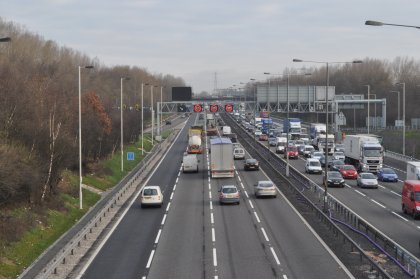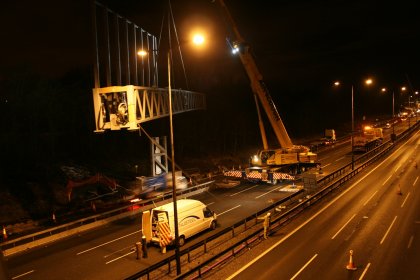Birmingham Box Managed Motorways Phases 1 & 2 |
75% |
Whole Project Award
Project Team:
Client: Highways Agency
Design: Mouchel
Construction: Carillion Civil Engineering
|
The Project
The M6 is a strategic route of national economic importance. In the West Midlands, with the M5 and M42, it links to form the Birmingham Motorway Box. This pivotal part of the UK motorway network has significant regional economic importance and for many years has suffered severe congestion and an above average accident record.
Previous studies identified that, through investment in key areas of the ‘Box’ infrastructure, significant transport benefits could be achieved which would support the Regional Economic Strategy to increase mobility and reduce business costs.
The subsequent commitment to investment resulted in delivery of the Pilot Active Traffic Management (ATM) regime on the M42 (junctions 3A to 7). ATM introduced variable speed control and the ability for traffic to use the hard shoulder during peak periods.
The success of the ATM Pilot assisted the Highways Agency in obtaining funding to further develop the ‘Box’. In 2008 the contract to deliver Birmingham Box Managed Motorways Phases 1 & 2 (BBMM12) was awarded to Carillion.
Phase 1 links to the ATM Pilot and extends the Managed Motorway benefits northwards along both the M42 and the M6. Phase 2 introduces Managed Motorways to the M6 between junctions 8 and 10A.
In 2008, the project was valued at £149m. Upon completion the combined team delivered all phases of the programme below budget saving more than £5 million.
As part of their tender submission, Carillion committed to using CEEQUAL and to complete a Whole Project Award.
Nuisance to Neighbours & Material Use
Establishing a project base depot, storage area and fabrication area for the steel super-span gantries without impacting on the local community was a key challenge. To achieve this, the team moved in to an existing, vacant warehouse unit on the Hams Hall Distribution Park near Coleshill. This existing warehouse unit was remote from any residential areas and provided a ‘ready to occupy’ facility without the need for temporary land acquisition and all the associated demands for access roads, car parks, lay-down areas all of which demand natural resources.
|
Transport
A further challenge was to reduce the environmental impact of the site transport. The project was spread out over 30km of the existing motorway network, in four independent sections, the demands on the engineering and supervisory teams to circumnavigate all of the working areas were high. The project invested in a fleet of hybrid electric cars to reduce fuel consumption levels. Combined with this, regular drivers undertook economic driver training courses to further increase the efficiency levels.
Ecology & Biodiversity
Despite all the works being within the existing highway boundary, there were a number of areas where protected species were present including badgers, water voles and Great Crested Newts. Working under the close supervision of an ecologist and also, where applicable, in accordance with Natural England’s licensing requirements, the project team successfully mitigated the impact of the project on a number of habitats.
|
Community Relations & Joy in Use
The majority of Phase 2 works were within an urban environment with many residential properties bordering the existing motorway. The project undertook an extensive public liaison and communication exercise to ensure local residents were aware of the scheme and particularly aware of the impacts of the ongoing construction works. The public liaison and communications exercise included; presentations to Councillors, public exhibitions, monthly ‘drop-in’ sessions, monthly newsletters and weekly works letters.




